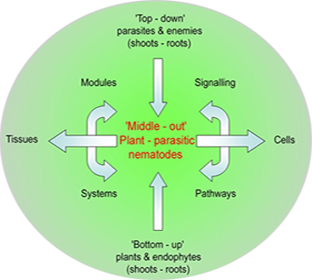Plant-parasitic nematodes affect root health by impairing water and nutrient uptake. Picture of a heavily galled tomato root infected with root-knot nematode
Core services
Integrated Systems Biology Approach "Middle out"
Since the middle of the last century the control of nematode pests has relied upon the use of chemicals that are bi-products of the petrochemical industry. Effective though these synthetic chemicals are at controlling nematodes, many are highly toxic and injurious to both human and environmental health. Therefore, over the last two decades these synthetic chemicals have been removed from the market through legislation in Europe, North America and elsewhere. It is most likely that this trend will continue into the foreseeable future and therefore new, robust, and environmentally benign control strategies are required.
Plant protection is a key component of crop productivity and plant-parasitic nematodes not only damage the plants directly, but also indirectly, through providing sites for secondary infections. At low population densities they usually cause little damage and crop yields remain above a threshold that is still economically favourable to the grower. However under conducive circumstances their population densities will increase dramatically and reduce yields below the economic threshold. The circumstances under which plant-parasitic nematodes will flourish are the result of three well established components; 1) the genetic backgrounds of the nematode - plant interaction, 2) the genetic background of the nematode - microbial enemy interaction, 3) inter and intra species competition between the nematodes dependent on the roots carrying capacity.
The interactions between the genetic components of this system are dependent on the expression of genes which are tissue and cell dependent, operating through signalling pathways and networks. This makes up a complex molecular system from the sub-cellular to the cellular and beyond, forming a nested hierarchy culminating in a community of interacting organisms. The relative balances of all these interacting populations will be affected by other external biotic and abiotic factors that impinge on the rhizosphere ecosystem.
K G Davies Limited therefore takes a multi-trophic integrated approach to plant health. This is a 'middle out' approach that puts the nematode pests at the centre, and relies on plant - pathosystems - biology to develop environmentally benign control strategies (see left diagram). We have expertise in the areas of Consultancy, Research and Development, Project Management and Training.

Integrated Systems Biology Approach "Middle-out"



